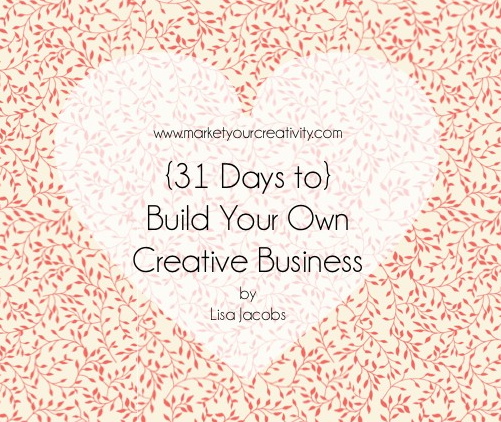Welcome back to {Day 25} of this 31-Day Build Your Own Creative Business series! I can hardly believe it’s almost over, and as always for the series, you can click to catch up from Day 1.
You owe it to your passion to treat it like a business and manage your time accordingly. That means not letting it grow like a hearty weed into every nook and cranny of your life, but giving it boundaries and tending to it the same way you’d nurture a lush garden. This takes a little planning, but I promise it will be well worth your efforts.
Name the results you want
I start any planning session by identifying what I hope to achieve, and I typically set 6-month goals for my business. Start by asking yourself a few questions:
- What is it that I want from this business in the next six months?
- What needs to happen over the next six months for me to feel successful in this business?
- What actions do I need to take to bring those goals into fruition?
- How many sales (for shop owners)/readers (for bloggers) do I hope to gain?
- What’s the exact dollar amount of profit that I need to earn in the next six months to prove this business is worth my time and effort?
Record your answers, and then …
List the action steps that will get you there
Do only the things that will lead you to the results you want. For example, if I spend an hour making treasuries on Etsy to try to get to to the popular page which helps me get views and shop hearts … well, those aren’t sales. I’ve learned over time and a steady lack of results, that treasuries bring me views and shop hearts – nothing else.
Therefore, your actions steps need to be a whole lot more of what you KNOW works for your business. If you’re just starting the business, do what you know works for other successful businesses in your industry. Here’s a list of the action steps I’m currently working on as an example:
I accomplish the following by January 30, 2014:
- Reconnect with my customers after a long transition apart
- Create and stock more designs
- Streamline my business operations: create a shipping “warehouse” out of an extra pantry closet
- Make 1,000 sales
- Find 250 new customers through advertising and referrals.
- Bring home at least $15,000 in profits.
Notice your natural rhythm
On an average day, you’ll find hours when you want to knock things off your list and hours when you want to sit online and chat. Tap into your own tendencies and energy levels so that you can use the natural rhythm of your productivity to your advantage.
For example, I’m writing this blog post first thing in the morning over my two cups of coffee. My children are still in my bed, my husband’s left for work, and it’s the perfect time to collect my thoughts and zone in on this message. By the time everyone’s up and ready for breakfast, I’ll be ready for a stretch and some movement, so I’ll use that break to clean up (myself and my home) for the day ahead. By the time I head back to my office, I’ll have a solid 3-hour work stretch before lunch. At 1 PM, I like to sit down with another cup of coffee, so I’m back on the computer. It’s the perfect time to chat or share on social media, or list new products in my shop. And so on and so forth.
Realize what drains energy and time from your day
Do you guys remember me from that meeting? My name’s Lisa, and I’m a clickaholic. In other words, I am an obsessive internet-clicker—my right index finger taps the computer mouse as naturally (and as often) as a heart beats. Nothing on the internet satisfies my need to know what’s happening, so I click and surf through all of my favorite sites (it’s especially unconscious behavior when I’m tired or procrastinating), waiting for something new to happen.
In the motivational book, This Year I Will…: How to Finally Change a Habit, Keep a Resolution, or Make a Dream Come True author M.J. Ryan titled one chapter: “What Need is Being Served by What You’re Doing Now?” Another version of that question is, “If this moment were a dollar, am I investing it? Or burning it?”
When I find myself saying that I’m “so busy,” I have to evaluate my schedule. 9 times out of 10, I’m so busy because the computer has been on all day, and I’ve been clicking away on it – eating up hours of valuable time. If you’re not a clicker, I challenge you to figure out where your time may be wasted.
It might be TV, virtual games (Candy Crush, anyone?), or YouTube. Our time wasters usually involve screens. Have you ever turned off all of the screens in your home and realized how productive you were that day? Once you have identified your time waster, it’s time to ask:
When are you most prone to time-wasting?
My susceptible time-wasting hours are in the morning, as my children are peacefully plotting the day’s play together. So that I will use this time wisely, I send this question to my phone via Google Calendar pop-ups: “What are you doing to get more orders right now?” You can also post this message on your computer, or wherever else you’re prone to time-wasting.
Create Productivity Blocks
To turn time from a pressure cooker into a pleasure, you must begin to pay attention to where you apply your attention. I can’t obsessively click my 6 favorite websites waiting for something to happen and make something happen at the same time. I have to proactively choose one or the other.
Every week, there are tasks on your to-do list that you simply do not want to do. I mean, that’s life – especially in a new, creative business. You wear many hats, remember? When those tasks crop up, can you feel the energy zap it causes?
Clicking around the internet, leaving piles of unfinished projects, calling a friend in the middle of a making session, etc. … these are all forms of procrastination. Acknowledge this fact! It’s equally empowering and time-enhancing.
In order to get stuff done and knock out those energy-draining tasks, whatever they may be, create an uninterrupted block of time in your day when you’ll work on NOTHING else. Now, if you’re new to this concept, think short but powerful sessions, and set a timer for 25 minutes. (ALWAYS use a timer with an alarm clock, it helps you keep your head down and stay focused on the task at hand.) Challenge yourself to get as much of that activity done as you possibly can. Take a 10 minute break, set your timer for another 25 minutes, and go back to work.
Try it just once and I promise, you’ll be amazed at the results you produce! You can gradually increase the time increments of production blocks, but never do more than 50 minutes at once or your focus will suffer. Always schedule at least a ten minute break between sessions to take a breather and refresh your intention.
How are you investing your moments?
When you spend your minutes wisely, your effort is always rewarded. And that’s that for {Day 25}!



Hey Lisa! Great advice. One tool I have just found (and it has a built in 25 minute timer) is http://www.Kanbanflow.com
I was the most productive I have been in weeks, but, more importantly, I was relaxed in the process! Because of the timer I was able to more fully concentrate on my work. Hope it can help others do the same.
Thanks! 🙂
Thanks, Emily. Great tip! I love using a timer when I’m working as well.
I have some friends whose LIVES have been taken over by Candy Crush. I ain’t touching that app with a 10-foot pole! 😉
One major tip that I find useful in my own business, is dealing with only 1 to 3 goals at a time. If you aren’t allowed to work on anything else until those goals are FINISHED, your impatience will drive you to accomplish things a lot faster.
It’s too easy to get distracted by the OOOH SHINY and end up working on a gazillion things at once, and therefore, end up accomplishing nothing. Dabblers waste time, while focusers get shyte DONE.
LOL about Candy Crush! It’s on my phone … total time zap. It is totally easy to get distracted by shiny things and new ideas. I completely agree (and guilty as charged). Thanks, Megan.